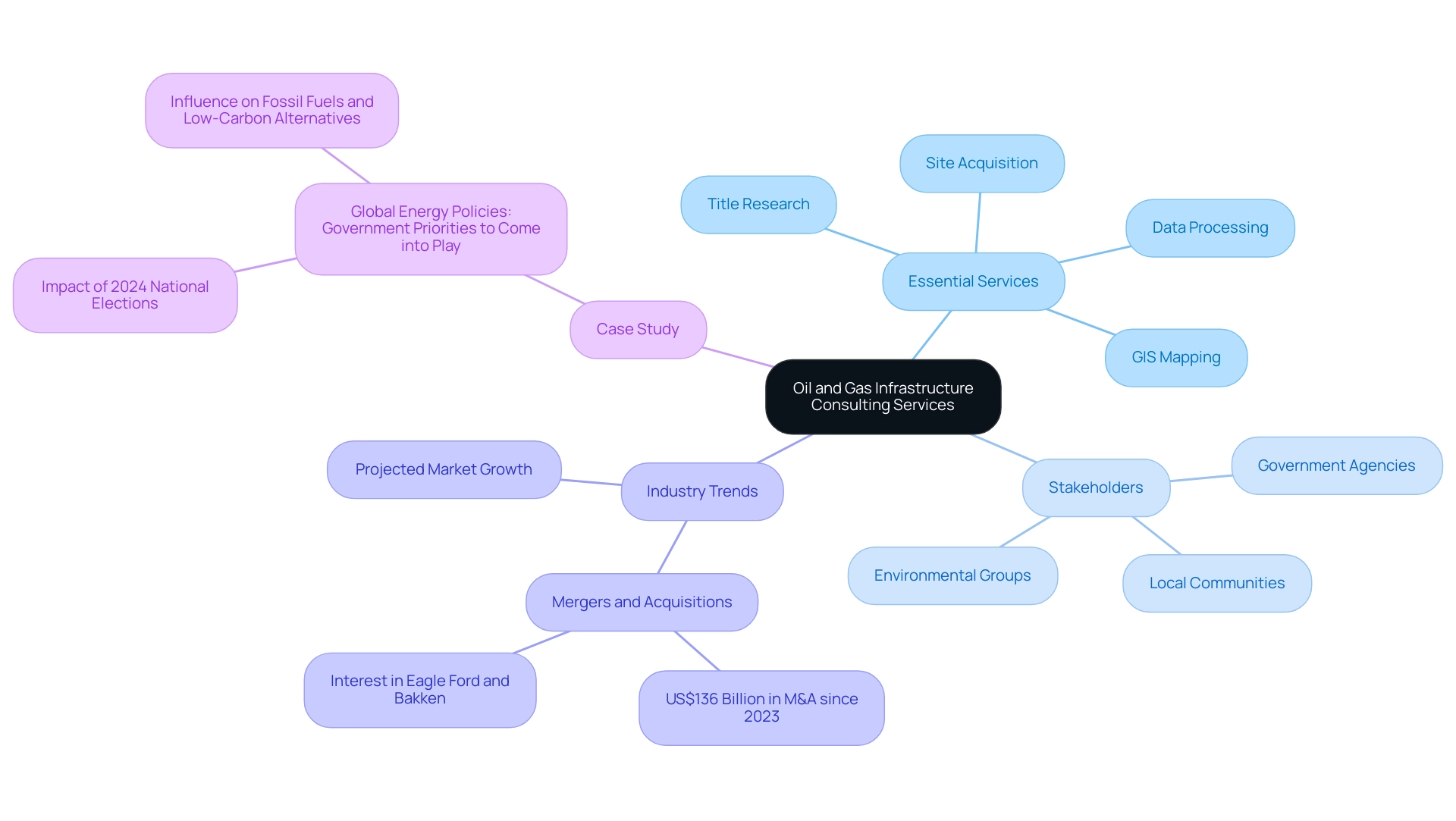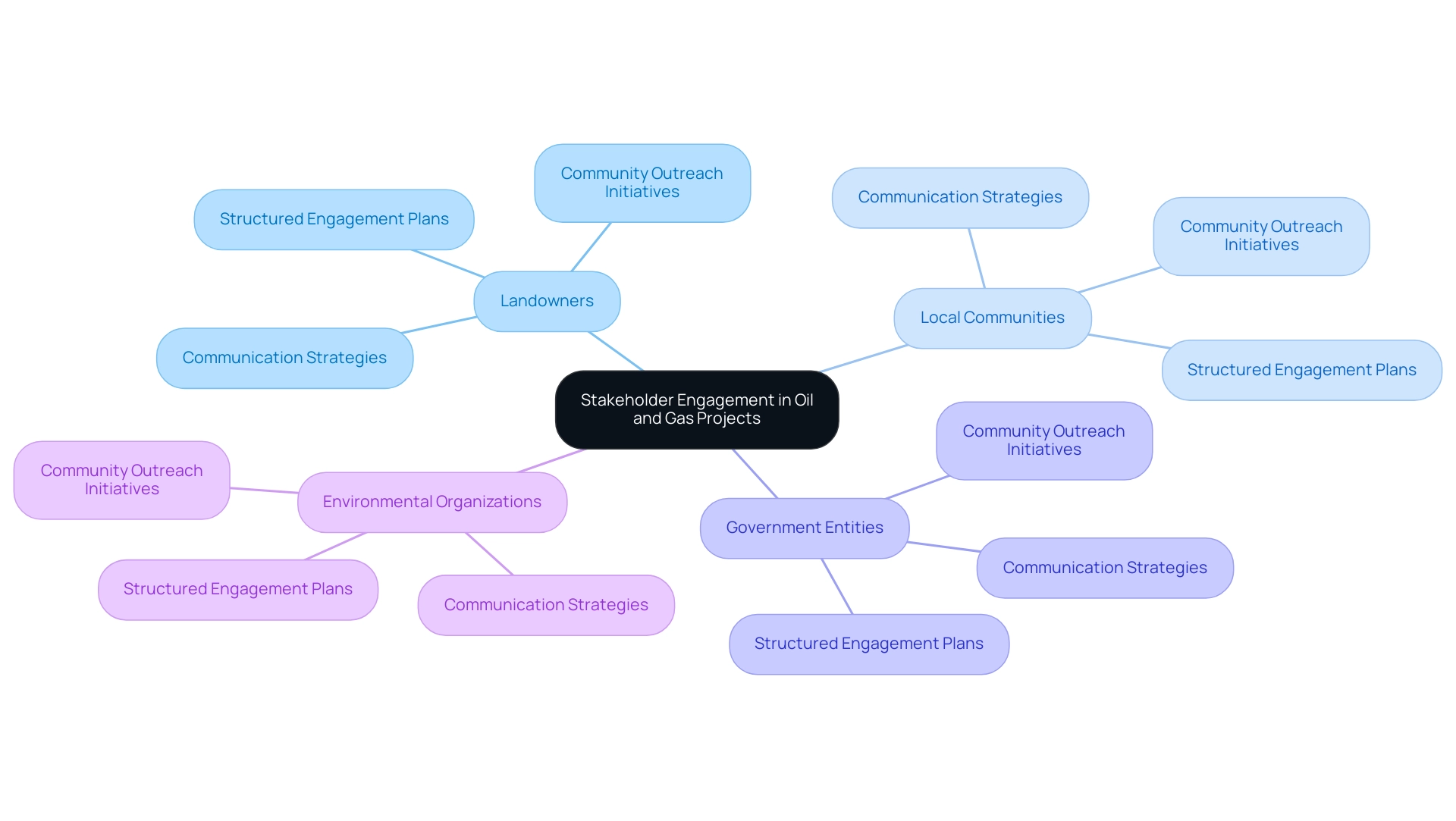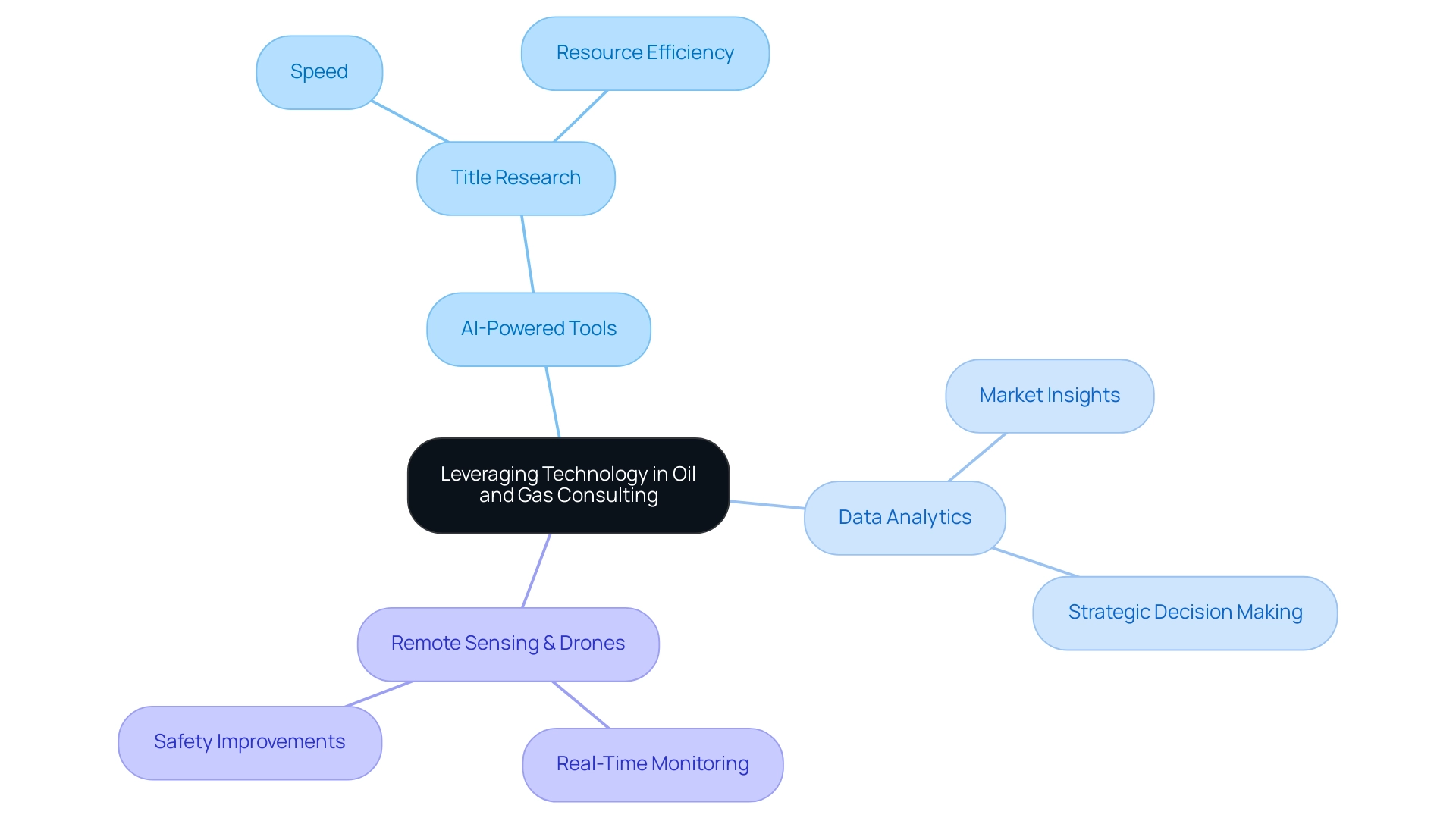Introduction
The oil and gas industry stands at a critical juncture, where the integration of advanced infrastructure and innovative consulting practices is paramount for navigating the complexities of energy production and distribution. As the demand for fossil fuels continues to evolve alongside a growing emphasis on sustainability, understanding the intricate web of oil and gas infrastructure becomes essential.
This article delves into key concepts surrounding the infrastructure that supports energy extraction, processing, and transportation, while also exploring the vital role of consulting services in addressing industry challenges. From the significance of Geographic Information Systems (GIS) mapping in project planning to the nuances of legal and regulatory compliance, the discussion highlights how effective stakeholder engagement and the adoption of cutting-edge technologies are reshaping the landscape of oil and gas consulting.
By examining these elements, the article provides a comprehensive overview of the current state of the industry and the strategic approaches necessary to ensure successful project execution in an increasingly complex environment.
Defining Oil and Gas Infrastructure: Key Concepts and Importance
Oil and gas infrastructure encompasses a broad array of physical assets and systems essential for the extraction, processing, and transportation of fossil fuels, including:
- Drilling rigs
- Pipelines
- Refineries
- Storage facilities
The significance of these components is profound, as they directly impact operational efficiency, regulatory compliance, and environmental stewardship. In 2023, sustainable debt issuances have exceeded USD 1 trillion for the third consecutive year, indicating a significant shift toward funding more environmentally friendly initiatives, including those in oil and gas infrastructure.
Notably, India's inaugural green bond issuance marks a significant advancement in sustainable finance, extending beyond traditional markets and underscoring the growing importance of sustainable investments in the industry. Robust infrastructure remains the backbone of the energy sector, ensuring a reliable supply of energy resources to consumers and industries alike. Furthermore, a well-structured infrastructure framework not only bolsters economic development but also enhances energy security.
As the International Energy Agency (IEA) notes,
Scaling up these instruments and mobilizing much greater support from development finance institutions will be critical to the continued broadening and acceleration of clean energy transitions.
The necessity of infrastructure in energy security cannot be overstated, as oil and gas infrastructure consulting serves as a focal point for efforts aimed at optimizing resource utilization and ensuring compliance with evolving industry standards. Moreover, historical insights from the World Energy Supplies Statistical Office of the United Nations provide valuable context, illustrating trends in energy supply and consumption that inform current infrastructure development strategies.
Ultimately, the impact of oil and gas infrastructure on energy security is critical, as it ensures not only the availability of energy resources but also the resilience of supply chains in the face of global challenges.
Consulting Services in Oil and Gas: Navigating Industry Challenges
Oil and gas infrastructure consulting services encompass a broad array of specialized offerings aimed at addressing the unique requirements of each endeavor. Essential services include:
- Site and right-of-way acquisition
- Title research
- GIS mapping
- Data processing
All of which play pivotal roles in navigating the industry's complexities. For instance, site acquisition necessitates a thorough understanding of legal frameworks and land ownership issues, while GIS mapping is critical for determining optimal routes for pipelines and other infrastructure developments.
These elements are especially relevant given recent trends, such as the nearly US$136 billion in mergers and acquisitions within the upstream sector since 2023, reflecting heightened interest in regions like the Eagle Ford and Bakken basins.
Effective consulting in the field of oil and gas infrastructure consulting also involves fostering collaboration among a diverse array of participants, including:
- Government agencies
- Local communities
- Environmental groups
Ensuring that all interests are taken into account. As Kate Hardin, Executive Director, observes, "The incorporation of advanced technologies, such as AI-driven title research software, has further improved the accuracy and efficiency of consulting services, resulting in better outcomes and increased client satisfaction." With the market in North America projected to grow significantly during the forecast period, staying abreast of the latest trends and addressing challenges faced by consultants will be vital for success in this evolving landscape.
Additionally, the case study titled 'Global Energy Policies: Government Priorities to Come into Play' highlights how the outcomes of the significant national elections in over 70 countries in 2024 could shape future policy approaches to fossil fuels and low-carbon alternatives. This context is essential for grasping the regulatory compliance challenges that consultants may encounter and the significance of effective management of involved parties in navigating these changes.

The Role of GIS Mapping in Oil and Gas Projects
Geographic Information Systems (GIS) mapping is essential in oil and gas infrastructure consulting, as it offers comprehensive spatial analysis and visualization of geographic data. This technology significantly enhances site selection processes by evaluating critical factors such as terrain, land use, and proximity to existing infrastructure. The integration of GIS in site selection ensures that potential sites are not only suitable for energy extraction but also compliant with environmental regulations.
For example, when planning a new pipeline, GIS facilitates the identification of the most efficient routes while minimizing environmental disturbances. According to Carolyn Hong Gui Qing, an author at Esri Indonesia’s conference, Pertamina Hulu Mahakam, a subsidiary of Pertamina, utilizes GIS technology to effectively manage their extensive data and assets, addressing complex operational challenges. Furthermore, GIS aids in environmental assessments by pinpointing sensitive areas and assessing the potential impacts of development activities.
This capability enables stakeholders to visualize implications clearly and collaborate more effectively, fostering informed decision-making. The current applications of GIS mapping in oil and gas infrastructure consulting initiatives demonstrate a trend towards enhanced planning and execution, contributing to safer and more efficient operations across the industry. With over 25 million members and 160 million publication pages, the relevance and credibility of GIS technology in the oil and gas sector are underscored.
Additionally, the high spatial, geomorphological, and biological heterogeneity of coralligenous assemblages in Liguria highlights the importance of GIS in environmental assessments. The proposed Integrated OLAP/GIS Analysis Architecture illustrates how GIS can unify business and spatial data, facilitating spatial-aware OLAP analysis and enhancing decision support in oil and gas infrastructure consulting initiatives.
Legal and Regulatory Considerations in Oil and Gas Consulting
Navigating the legal and regulatory landscape presents one of the most formidable challenges in oil and gas infrastructure consulting. Professionals in this field must possess a comprehensive understanding of local, state, and federal regulations that govern land use, environmental protection, and resource extraction. Key aspects include:
- Obtaining necessary permits
- Conducting thorough environmental impact assessments
- Ensuring adherence to safety standards
The recent amendments to the Natural Gas Act, aimed at streamlining the approval process for LNG export facilities, exemplify the dynamic nature of regulatory requirements. This legislative change, discussed in the case study 'Unlocking Domestic LNG Potential,' grants the Federal Energy Regulatory Commission exclusive authority to approve or deny applications, underscoring the importance of compliance in project execution.
Moreover, consulting firms must excel in managing negotiations with both landowners and regulatory bodies, as these relationships are crucial for successful outcomes. For instance, effective engagement with involved parties can significantly enhance the likelihood of permit acquisition, with success rates reported at approximately 75% when comprehensive strategies are employed.
Staying informed about evolving regulations is essential to mitigate risks and avoid costly delays. Legal specialists, such as Jason M. Loring, stress that a proactive strategy for compliance, including thorough due diligence and ongoing engagement with involved parties, is essential to ensure all legal obligations are fulfilled and to navigate the complexities of oil and gas infrastructure consulting in 2024. Loring's insights on AI use policy highlight how technology can streamline compliance processes, further emphasizing the need for adaptability in business communications within the sector.
Stakeholder Engagement and Management in Oil and Gas Projects
Effective involvement of interested parties is crucial for the successful implementation of initiatives in oil and gas infrastructure consulting, as it fosters collaboration and trust among various groups, including landowners, local communities, government entities, and environmental organizations. A structured engagement plan is crucial, outlining communication strategies that convey objectives, address concerns, and involve them in the decision-making process. Regular updates and transparent communication channels are crucial in reducing opposition and fostering a collaborative environment.
The 2024 emphasis on community outreach initiatives is particularly relevant, as these efforts not only improve public perception but also garner support for projects. For instance, the Dakota Access Pipeline case study illustrates the critical role of interest group analysis and engagement in addressing environmental and cultural concerns. Additionally, a study on participant engagement in the oil and gas sector revealed that effective practices in oil and gas infrastructure consulting enhance citizen satisfaction and perceptions of transparency, leading to better community outcomes and diminished public discontent.
This study, financed by the International Initiative for Impact Evaluation on behalf of the British Department for International Development, found compelling evidence supporting the effectiveness of participant engagement practices. Furthermore, with 488 respondents reporting someone in their household using social networking services, it underscores the necessity for companies to leverage these platforms for effective communication and engagement. As noted by Steve Bennett, a Business Formation Expert,
With LLCBuddy, you're not just getting a tutorial; you're gaining a trustworthy partner for your entrepreneurial journey.
This highlights the value of partnerships in stakeholder engagement. By prioritizing these strategies, firms specializing in oil and gas infrastructure consulting can navigate potential conflicts and facilitate smoother implementation.

Leveraging Technology in Oil and Gas Consulting
In the rapidly evolving landscape of the oil and gas industry, the adoption of advanced technology is crucial for optimizing oil and gas infrastructure consulting. Analysts anticipate a modest 0.5% yearly increase in the oil and gas industry's capital investment in 2025, underscoring the need for effective technology integration. The incorporation of AI-powered title research software, sophisticated data analytics tools, and cutting-edge surveying technologies has transformed how oil and gas infrastructure consulting operates, leading to enhanced efficiency and accuracy.
For example, AI can significantly expedite the title research process by swiftly analyzing extensive property records, thereby minimizing the time and resources required for due diligence. Furthermore, data analytics provides valuable insights into market trends and feasibility, which are essential for informed strategic decision-making. The use of remote sensing and drone technology also plays a pivotal role in enabling real-time monitoring of project sites, thereby improving safety protocols and reducing operational costs.
As noted by industry expert Rahul Bodega, 'The integration of technology not only streamlines processes but also aligns our approaches in oil and gas infrastructure consulting with the evolving demands of the industry.' Additionally, the recent case study titled 'Global Energy Policies: Government Priorities to Come into Play' highlights how national elections have affected energy policy, potentially influencing the pace of the energy transition and the adoption of new technologies. By incorporating these innovative technologies, firms in oil and gas infrastructure consulting can provide superior outcomes that align more closely with their clients' evolving needs, ultimately fostering a more agile and responsive consulting environment.

Conclusion
The oil and gas industry is undergoing significant transformation, driven by advancements in infrastructure and innovative consulting practices. The article underscores the critical importance of robust oil and gas infrastructure, which serves as the backbone of energy production and distribution. This infrastructure not only enhances operational efficiency but also plays a pivotal role in ensuring regulatory compliance and promoting sustainability. The increasing trend of sustainable finance reflects a broader commitment to integrating environmental considerations into the industry's future, highlighting the need for investments that support greener projects.
Consulting services emerge as essential partners in navigating the complexities of the sector. By leveraging advanced technologies such as GIS mapping and AI-driven solutions, consulting firms can optimize project planning and execution, ensuring that all aspects—from legal compliance to stakeholder engagement—are meticulously managed. The emphasis on effective stakeholder engagement is particularly noteworthy, as it fosters collaboration and trust among diverse groups, ultimately leading to smoother project implementations and improved public perception.
In conclusion, the intersection of advanced technology, stakeholder management, and sustainable infrastructure is reshaping the oil and gas landscape. The industry's ability to adapt to evolving demands and regulatory frameworks will be crucial for its success in the coming years. As the global energy landscape continues to shift, embracing these strategic approaches will not only enhance operational resilience but also contribute to a sustainable energy future that addresses both economic and environmental challenges. The path forward is clear: a commitment to innovation, collaboration, and responsible resource management will define the next era of oil and gas consulting.
Frequently Asked Questions
What is included in oil and gas infrastructure?
Oil and gas infrastructure includes a variety of physical assets and systems essential for the extraction, processing, and transportation of fossil fuels, such as drilling rigs, pipelines, refineries, and storage facilities.
Why is oil and gas infrastructure significant?
The significance of oil and gas infrastructure lies in its impact on operational efficiency, regulatory compliance, and environmental stewardship. It is crucial for ensuring a reliable supply of energy resources and enhancing energy security.
What recent financial trends are impacting oil and gas infrastructure?
In 2023, sustainable debt issuances have exceeded USD 1 trillion for the third consecutive year, indicating a shift toward funding environmentally friendly initiatives in oil and gas infrastructure, including India's inaugural green bond issuance.
How does robust infrastructure contribute to energy security?
Robust infrastructure is essential for energy security as it ensures the availability of energy resources and the resilience of supply chains against global challenges, thereby supporting economic development.
What role does oil and gas infrastructure consulting play?
Oil and gas infrastructure consulting focuses on optimizing resource utilization and ensuring compliance with industry standards. It includes services like site and right-of-way acquisition, title research, GIS mapping, and data processing.
What are some key services provided by oil and gas infrastructure consulting?
Key services include site and right-of-way acquisition, title research, GIS mapping, and data processing, which help navigate the complexities of the oil and gas industry.
What recent trends are influencing the oil and gas consulting market?
There has been nearly US$136 billion in mergers and acquisitions within the upstream sector since 2023, indicating increased interest in regions like the Eagle Ford and Bakken basins.
How important is collaboration in oil and gas infrastructure consulting?
Collaboration among government agencies, local communities, and environmental groups is crucial to ensure that all interests are considered in the consulting process.
What technological advancements are improving consulting services in the oil and gas sector?
The incorporation of advanced technologies, such as AI-driven title research software, has enhanced the accuracy and efficiency of consulting services, leading to better outcomes and increased client satisfaction.
How might future government policies affect oil and gas infrastructure consulting?
The outcomes of significant national elections in over 70 countries in 2024 could shape future policy approaches to fossil fuels and low-carbon alternatives, impacting regulatory compliance challenges for consultants.
List of Sources
- Defining Oil and Gas Infrastructure: Key Concepts and Importance
- Overview and key findings – World Energy Investment 2023 – Analysis - IEA (https://iea.org/reports/world-energy-investment-2023/overview-and-key-findings)
- Research Guides: Oil and Gas Industry: A Research Guide: Statistical Data (https://guides.loc.gov/oil-and-gas-industry/statistical-data)
- Overview and key findings – World Energy Investment 2024 – Analysis - IEA (https://iea.org/reports/world-energy-investment-2024/overview-and-key-findings)
- Consulting Services in Oil and Gas: Navigating Industry Challenges
- Oil and Gas Consulting Service Market Size and Growth Share 2024 : Future Trends and Developments to 2032 (https://linkedin.com/pulse/oil-gas-consulting-service-market-size-lgmjf?published=t)
- 2025 Oil and Gas Industry Outlook (https://www2.deloitte.com/us/en/insights/industry/oil-and-gas/oil-and-gas-industry-outlook.html)
- IBISWorld - Industry Market Research, Reports, and Statistics (https://ibisworld.com/industry-statistics/employment/oil-gas-mining-consultants-united-states)
- The Role of GIS Mapping in Oil and Gas Projects
- (PDF) Oil & Gas Industry Mapping Analysis with GIS Approach: A Literature Review (https://researchgate.net/publication/338800615_Oil_Gas_Industry_Mapping_Analysis_with_GIS_Approach_A_Literature_Review)
- (PDF) THE ROLE OF GIS IN OIL INDUSTRY MANAGEMENT (https://researchgate.net/publication/330566682_THE_ROLE_OF_GIS_IN_OIL_INDUSTRY_MANAGEMENT)
- Legal and Regulatory Considerations in Oil and Gas Consulting
- Environmental Shift: Insight into Administrative Changes (https://natlawreview.com/article/environmental-shift-insight-administrative-changes)
- BLM Finalizes Regulations to Reduce Flaring, Natural Gas Waste on Federal and Indian Leases (https://bhfs.com/insights/alerts-articles/2024/blm-finalizes-regulations-to-reduce-flaring-natural-gas-waste-on-federal-and-indian-leases)
- Text - H.R.1 - 118th Congress (2023-2024): Lower Energy Costs Act (https://congress.gov/bill/118th-congress/house-bill/1/text/eh?format=txt&utm_medium=email&utm_source=substack)
- Stakeholder Engagement and Management in Oil and Gas Projects
- Oil and Gas Project Management Statistics 2025 – Everything You Need to Know (https://llcbuddy.com/data/oil-and-gas-project-management-statistics)
- Stakeholder engagement increases transparency, satisfaction, and civic action - PMC (https://pmc.ncbi.nlm.nih.gov/articles/PMC6900517)
- Key Stakeholders in the Oil and Gas Industry (https://boreal-is.com/blog/oil-and-gas-stakeholders)
- Leveraging Technology in Oil and Gas Consulting
- 2025 Oil and Gas Industry Outlook (https://www2.deloitte.com/us/en/insights/industry/oil-and-gas/oil-and-gas-industry-outlook.html)
- mckinsey.com (https://mckinsey.com/capabilities/mckinsey-digital/our-insights/the-top-trends-in-tech)




